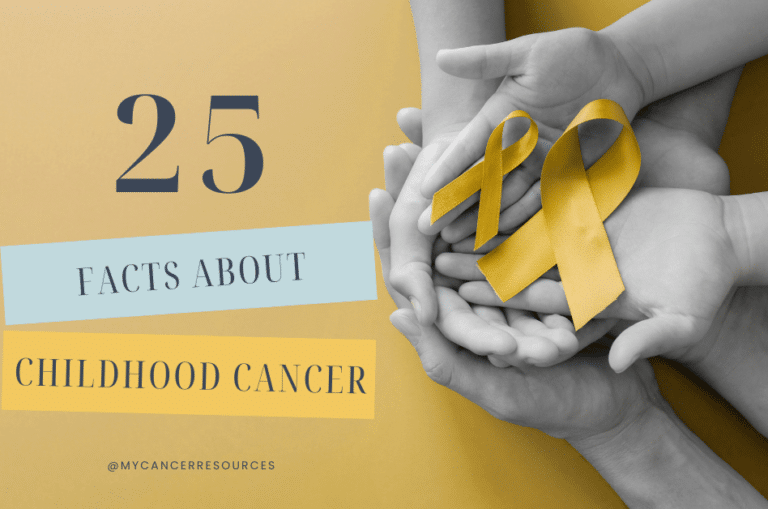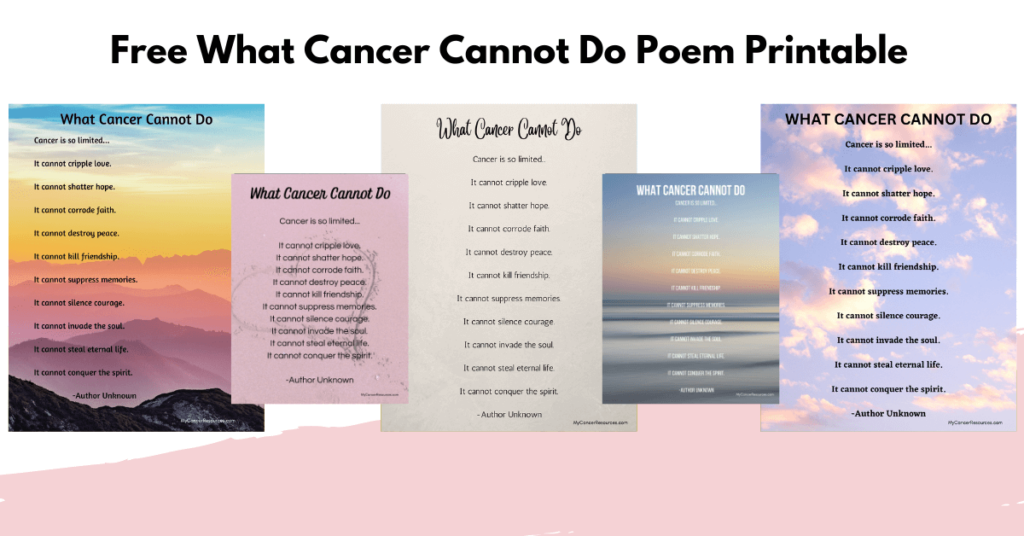
September is National Childhood Cancer Awareness Month, and in honor of that, I’m sharing 25 facts about children’s cancer. This is a topic near and dear to my heart as my path to becoming a pediatric oncology social worker and eventually writing my PhD dissertation on pediatric oncology began decades ago when I volunteered at Camp Mak-A-Dream in Gold Creek, Montana. Let’s dive into these childhood cancer facts.
BONUS FACT: Do you know why the gold ribbon was selected to represent childhood cancer awareness? A group of parents of children with cancer had gotten together and formed the Candlelighters Children’s Cancer Foundation (now known as the American Children’s Cancer Organization (ACCO). They considered many colors for the awareness ribbon, but settled on gold because gold is a precious metal, so it’s the perfect color to reflect the most precious thing in our lives—our children.
Diagnosis
1. Approximately 400,000 kids (including teens/young adults) develop cancer each year, though only 1/2 of these are diagnosed. Most of those undiagnosed cases are in low-income countries.
2. About 17,000 children are diagnosed in the U.S. each year.
3. Childhood cancer isn’t just one disease – there are over 12 major types of pediatric cancers, with more than a hundred subtypes.
4. The average age at diagnosis is 8 years old.
5. Childhood cancer rates are on the rise, increasing about 1% each year.
6. 1 in 285 kids will be diagnosed before their 20th birthday.
Types of Childhood Cancer
7. The most common types of cancers diagnosed in children are:
- Leukemia is a blood cancer, where the bone marrow produces too many blood cells, and those blood cells don’t work correctly. There are several types of leukemia, the most common being acute lymphoblastic leukemia. All types of leukemias combined make up 28% of all pediatric cancers.
- Brain and spinal cord tumors. There are many different types of brain cancer, some of which can be very difficult to treat. These make up about 26% of childhood cancers.
- Neuroblastoma, which develops in nerve tissue and is most common in newborn infants and babies. About 6% of pediatric cancers are neuroblastomas.
- Wilms tumor is a type of kidney cancer that is most common in 3 to 4-year-olds, and accounts for about 5% of diagnoses.
- Lymphoma is cancer of the lymph nodes. There are two types: Hodgkin (3% of all diagnoses) and non-Hodgkin lymphoma (5% of all childhood cancers).
- Rhabdomyosarcoma is a soft tissue cancer that makes up 3% of childhood cancers.
- Retinoblastoma is cancer of the eye that makes up 2% of childhood cancer diagnoses. It’s rarely found in children more than 6 years of age.
- Bone cancer (including osteosarcoma and Ewing sarcoma) These can develop at any age but are most common in older children and teens.
Treatment
8. The causes of childhood cancer are different than adult cancers. Many adult cancers are linked to environmental risk factors and lifestyle factors. The causes of most childhood cancers are thought to be a result of genetic changes within the body that develop into cancer cells. Sometimes the causes are unknown.
9. Childhood cancer treatment is different than treatment for adult cancers. Cancer and its treatment are more likely to affect developing organs in a child’s body, so some adult cancer treatments cannot be used in kids.
10. Most of the current standard treatments in use today in pediatric cancer were approved before 1990.
11. Between the years of 2009 and 2019, 9 out of the 11 drugs used to treat acute lymphoblastic leukemia, the most common childhood cancer were in and out of shortage.
12. As of 2020, only 6 drugs had been approved by the Food and Drug Administration specifically for childhood cancer. (Side note: THIS is why funding pediatric cancer research and clinical trials to develop new treatments is so critical! We need more options, new drugs and better treatments for these kids.)
Survival
13. More than 80% of U.S. kids who had cancer become long-term survivors.
14. In the United States, there are more than half a million childhood cancer survivors.
15. The average 5-year survival rate for all childhood cancers together is 86%.
16. Depending on the type of cancer, 5-year survival rates can range from 2% to 90%.
Death
17. Cancer is the leading disease-related cause of death for children past infancy.
18. Brain tumors are the deadliest type of childhood cancer, accounting for 30% of all deaths in pediatric patients.
19. Children with cancer in low-income countries are up to 10 times more likely to die from their disease than children in high-income countries.
20. The most common causes of death for childhood cancer survivors are:
a) The original cancer returns.
b) A different type of cancer develops and
c) Heart and lung damage.
Ongoing Complications
21. More than 95% of survivors of childhood cancer will develop significant health-related issues by the time they reach 45 years old. These late effects can be due to the cancer itself or, more likely, as a result of its treatment, and can include side effects like neuropathy, cognitive impairments, and heart disease.
22. One-third of these survivors will suffer from severe and chronic health conditions. Another third will suffer from moderate to severe health problems.
23. One large study found that almost 10% of pediatric cancer survivors developed a second cancer within 30 years after their initial diagnosis. These secondary cancers are typically breast, bone, and thyroid cancer.
24. Children who received treatment for brain tumors, bone cancer, and Hodgkin lymphoma or those who received radiation to their chest, abdomen or pelvis have the highest risk of serious late effects from their cancer treatment, including second cancers, joint replacement, hearing loss, and congestive heart failure.
Funding
25. Children’s cancer research receives only about 4% of all federal research funding that’s set aside for cancer research. Only 4%! And that covers ALL pediatric cancers.
Childhood cancer research is severely underfunded, so many incredible organizations raise money to fund much-needed research to discover new approaches to treatment, better treatment, and more cures.
Final Thoughts
Research has come a long way in improving childhood cancer survival rates, but there is so much more work to be done to save the lives of children, especially those living in poor regions and countries. We are lucky here in the United States to have access to innovative treatments such as CAR T-Cell (CAR T) immunotherapy and incredible hospitals like St. Jude Children’s Research Hospital to provide exceptional care for children with all types of life-threatening diseases, not just cancer, at no cost.
I believe it is completely unfair to designate so little funding towards pediatric cancer research, especially since children are the future of our communities, our country, and the world.
They deserve better.
References
 September is National Childhood Cancer Awareness Month, and in honor of that, I’m sharing 25 facts about children’s cancer. This is a topic near and dear to my heart as my path to becoming a pediatric oncology social worker and eventually writing my PhD dissertation on pediatric oncology began decades ago when I volunteered at Camp Mak-A-Dream in Gold Creek, Montana. Let’s dive into these childhood cancer facts.
BONUS FACT: Do you know why the gold ribbon was selected to represent childhood cancer awareness? A group of parents of children with cancer had gotten together and formed the Candlelighters Children’s Cancer Foundation (now known as the American Children’s Cancer Organization (ACCO). They considered many colors for the awareness ribbon, but settled on gold because gold is a precious metal, so it’s the perfect color to reflect the most precious thing in our lives—our children.
September is National Childhood Cancer Awareness Month, and in honor of that, I’m sharing 25 facts about children’s cancer. This is a topic near and dear to my heart as my path to becoming a pediatric oncology social worker and eventually writing my PhD dissertation on pediatric oncology began decades ago when I volunteered at Camp Mak-A-Dream in Gold Creek, Montana. Let’s dive into these childhood cancer facts.
BONUS FACT: Do you know why the gold ribbon was selected to represent childhood cancer awareness? A group of parents of children with cancer had gotten together and formed the Candlelighters Children’s Cancer Foundation (now known as the American Children’s Cancer Organization (ACCO). They considered many colors for the awareness ribbon, but settled on gold because gold is a precious metal, so it’s the perfect color to reflect the most precious thing in our lives—our children.
Diagnosis
1. Approximately 400,000 kids (including teens/young adults) develop cancer each year, though only 1/2 of these are diagnosed. Most of those undiagnosed cases are in low-income countries. 2. About 17,000 children are diagnosed in the U.S. each year. 3. Childhood cancer isn’t just one disease – there are over 12 major types of pediatric cancers, with more than a hundred subtypes. 4. The average age at diagnosis is 8 years old. 5. Childhood cancer rates are on the rise, increasing about 1% each year. 6. 1 in 285 kids will be diagnosed before their 20th birthday.Types of Childhood Cancer
7. The most common types of cancers diagnosed in children are:- Leukemia is a blood cancer, where the bone marrow produces too many blood cells, and those blood cells don’t work correctly. There are several types of leukemia, the most common being acute lymphoblastic leukemia. All types of leukemias combined make up 28% of all pediatric cancers.
- Brain and spinal cord tumors. There are many different types of brain cancer, some of which can be very difficult to treat. These make up about 26% of childhood cancers.
- Neuroblastoma, which develops in nerve tissue and is most common in newborn infants and babies. About 6% of pediatric cancers are neuroblastomas.
- Wilms tumor is a type of kidney cancer that is most common in 3 to 4-year-olds, and accounts for about 5% of diagnoses.
- Lymphoma is cancer of the lymph nodes. There are two types: Hodgkin (3% of all diagnoses) and non-Hodgkin lymphoma (5% of all childhood cancers).
- Rhabdomyosarcoma is a soft tissue cancer that makes up 3% of childhood cancers.
- Retinoblastoma is cancer of the eye that makes up 2% of childhood cancer diagnoses. It’s rarely found in children more than 6 years of age.
- Bone cancer (including osteosarcoma and Ewing sarcoma) These can develop at any age but are most common in older children and teens.
Treatment
8. The causes of childhood cancer are different than adult cancers. Many adult cancers are linked to environmental risk factors and lifestyle factors. The causes of most childhood cancers are thought to be a result of genetic changes within the body that develop into cancer cells. Sometimes the causes are unknown. 9. Childhood cancer treatment is different than treatment for adult cancers. Cancer and its treatment are more likely to affect developing organs in a child’s body, so some adult cancer treatments cannot be used in kids. 10. Most of the current standard treatments in use today in pediatric cancer were approved before 1990. 11. Between the years of 2009 and 2019, 9 out of the 11 drugs used to treat acute lymphoblastic leukemia, the most common childhood cancer were in and out of shortage. 12. As of 2020, only 6 drugs had been approved by the Food and Drug Administration specifically for childhood cancer. (Side note: THIS is why funding pediatric cancer research and clinical trials to develop new treatments is so critical! We need more options, new drugs and better treatments for these kids.)Survival
13. More than 80% of U.S. kids who had cancer become long-term survivors. 14. In the United States, there are more than half a million childhood cancer survivors. 15. The average 5-year survival rate for all childhood cancers together is 86%. 16. Depending on the type of cancer, 5-year survival rates can range from 2% to 90%.Death
17. Cancer is the leading disease-related cause of death for children past infancy. 18. Brain tumors are the deadliest type of childhood cancer, accounting for 30% of all deaths in pediatric patients. 19. Children with cancer in low-income countries are up to 10 times more likely to die from their disease than children in high-income countries. 20. The most common causes of death for childhood cancer survivors are: a) The original cancer returns. b) A different type of cancer develops and c) Heart and lung damage.Ongoing Complications
21. More than 95% of survivors of childhood cancer will develop significant health-related issues by the time they reach 45 years old. These late effects can be due to the cancer itself or, more likely, as a result of its treatment, and can include side effects like neuropathy, cognitive impairments, and heart disease. 22. One-third of these survivors will suffer from severe and chronic health conditions. Another third will suffer from moderate to severe health problems. 23. One large study found that almost 10% of pediatric cancer survivors developed a second cancer within 30 years after their initial diagnosis. These secondary cancers are typically breast, bone, and thyroid cancer. 24. Children who received treatment for brain tumors, bone cancer, and Hodgkin lymphoma or those who received radiation to their chest, abdomen or pelvis have the highest risk of serious late effects from their cancer treatment, including second cancers, joint replacement, hearing loss, and congestive heart failure.Funding
25. Children’s cancer research receives only about 4% of all federal research funding that’s set aside for cancer research. Only 4%! And that covers ALL pediatric cancers. Childhood cancer research is severely underfunded, so many incredible organizations raise money to fund much-needed research to discover new approaches to treatment, better treatment, and more cures.Final Thoughts
Research has come a long way in improving childhood cancer survival rates, but there is so much more work to be done to save the lives of children, especially those living in poor regions and countries. We are lucky here in the United States to have access to innovative treatments such as CAR T-Cell (CAR T) immunotherapy and incredible hospitals like St. Jude Children’s Research Hospital to provide exceptional care for children with all types of life-threatening diseases, not just cancer, at no cost. I believe it is completely unfair to designate so little funding towards pediatric cancer research, especially since children are the future of our communities, our country, and the world. They deserve better.References
www.acco.org/blog/6-facts-about-childhood-cancer www.acco.org/gold-ribbon-awareness www.cancer.gov/types/childhood-cancer www.cancer.org/cancer/types/cancer-in-children/types-of-childhood-cancers.html cac2.org/interest-groups/awareness/childhood-cancer-fact-library curesearch.org/childhood-cancer-statisticswww.acco.org/blog/6-facts-about-childhood-cancer
www.acco.org/gold-ribbon-awareness
www.cancer.gov/types/childhood-cancer
www.cancer.org/cancer/types/cancer-in-children/types-of-childhood-cancers.html
cac2.org/interest-groups/awareness/childhood-cancer-fact-library
curesearch.org/childhood-cancer-statistics



